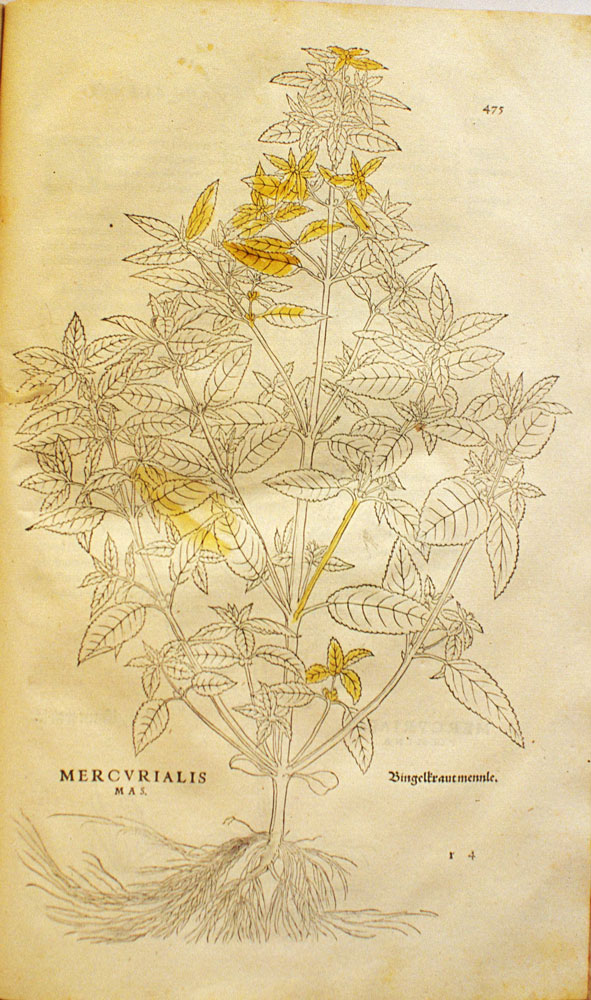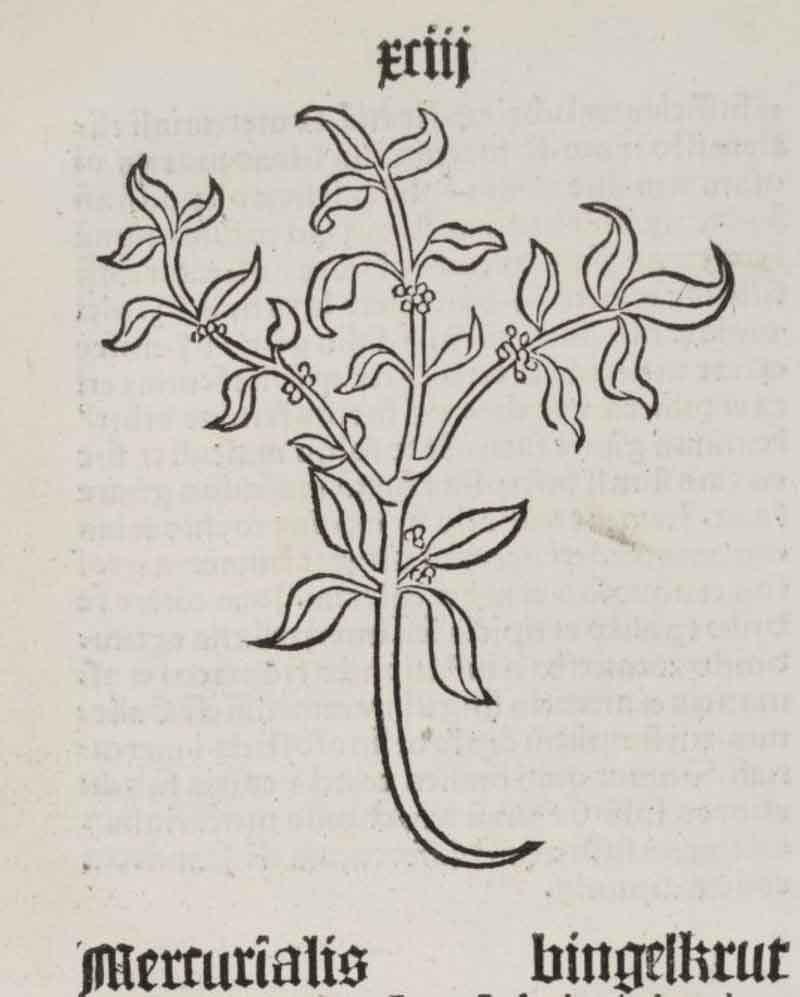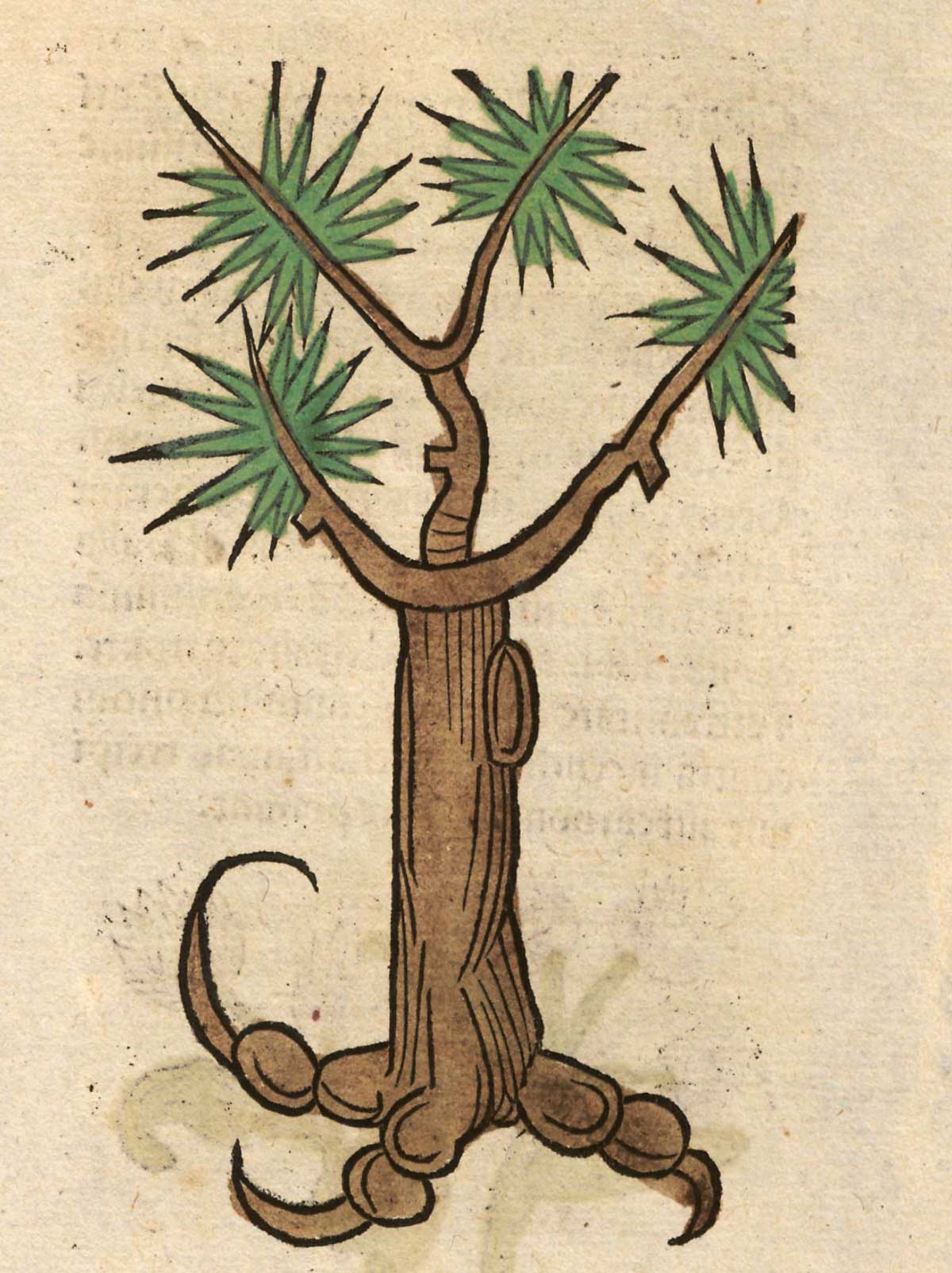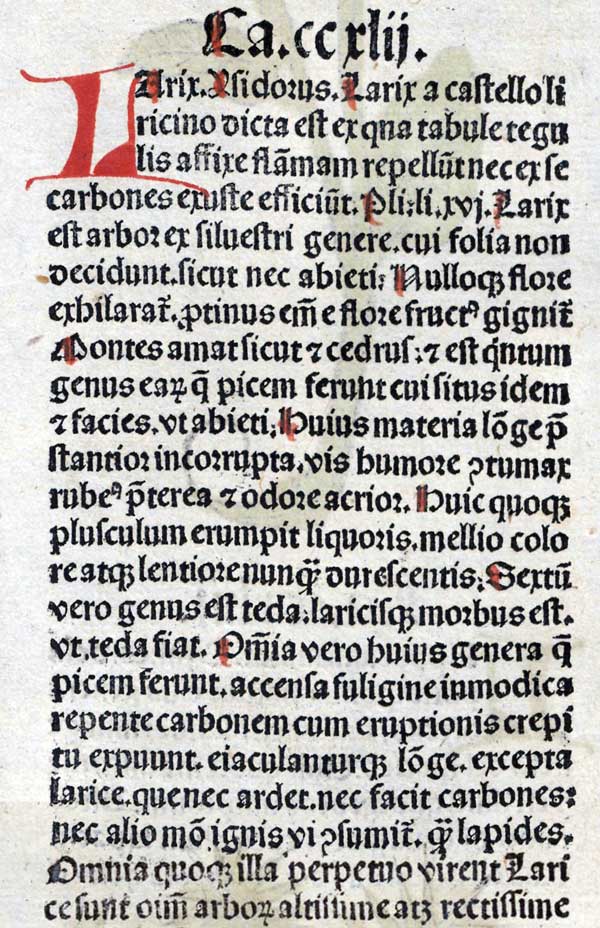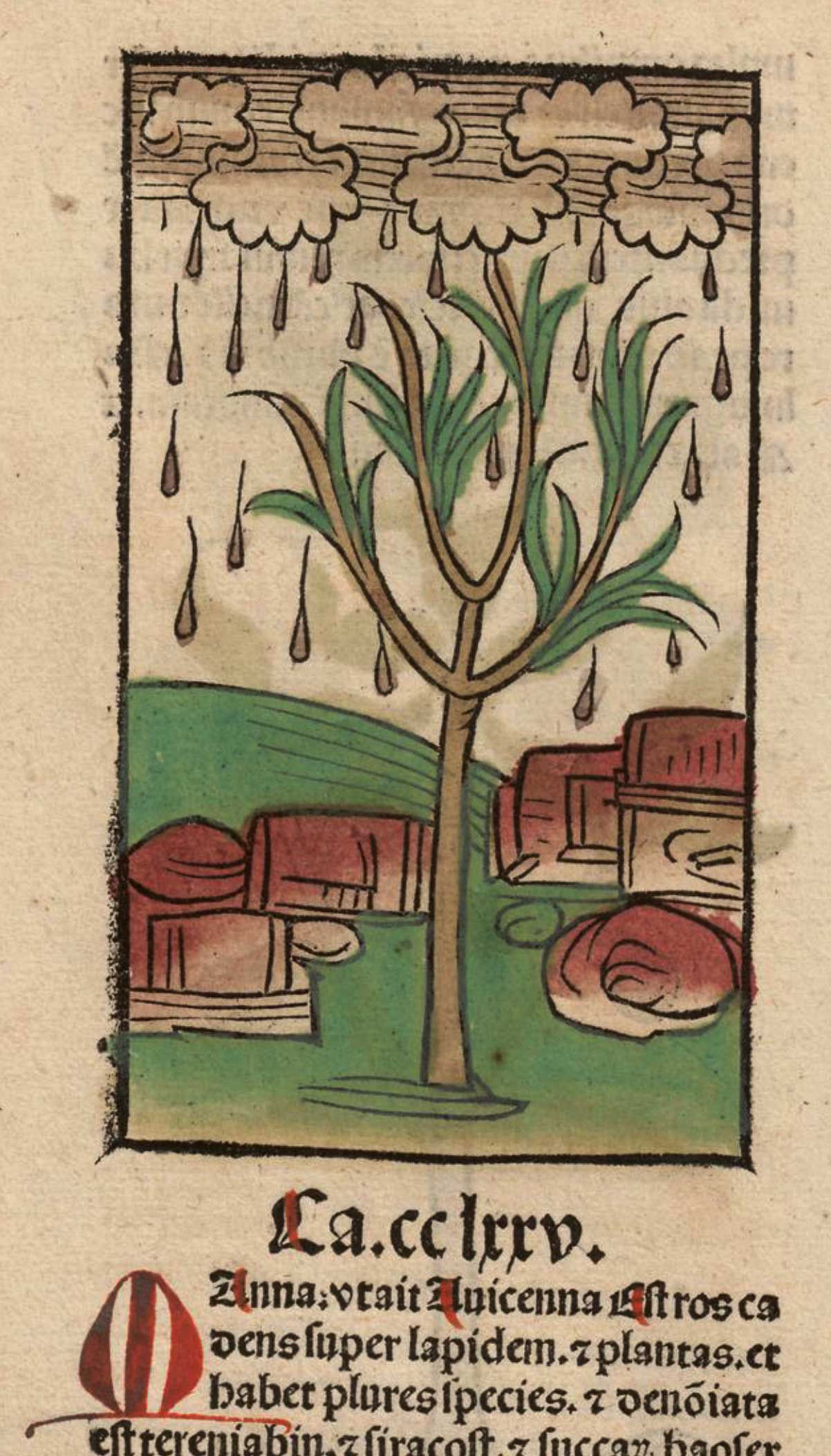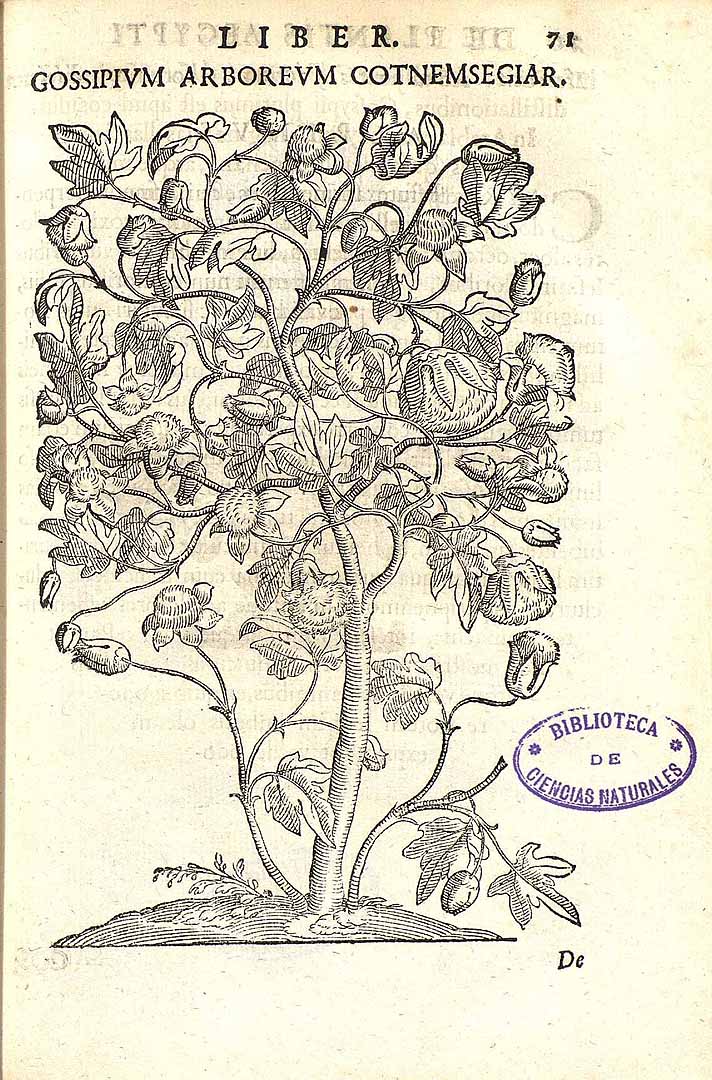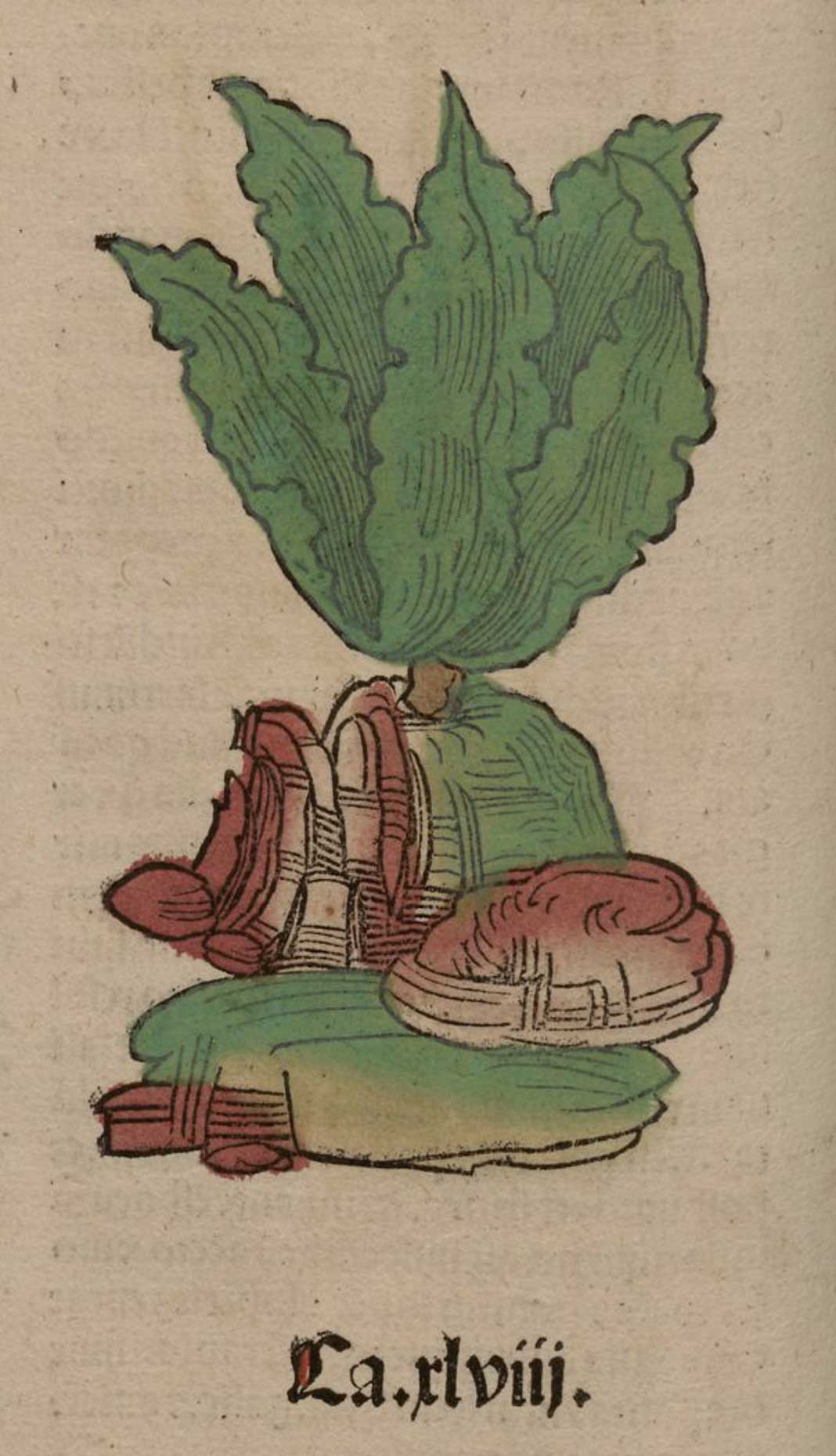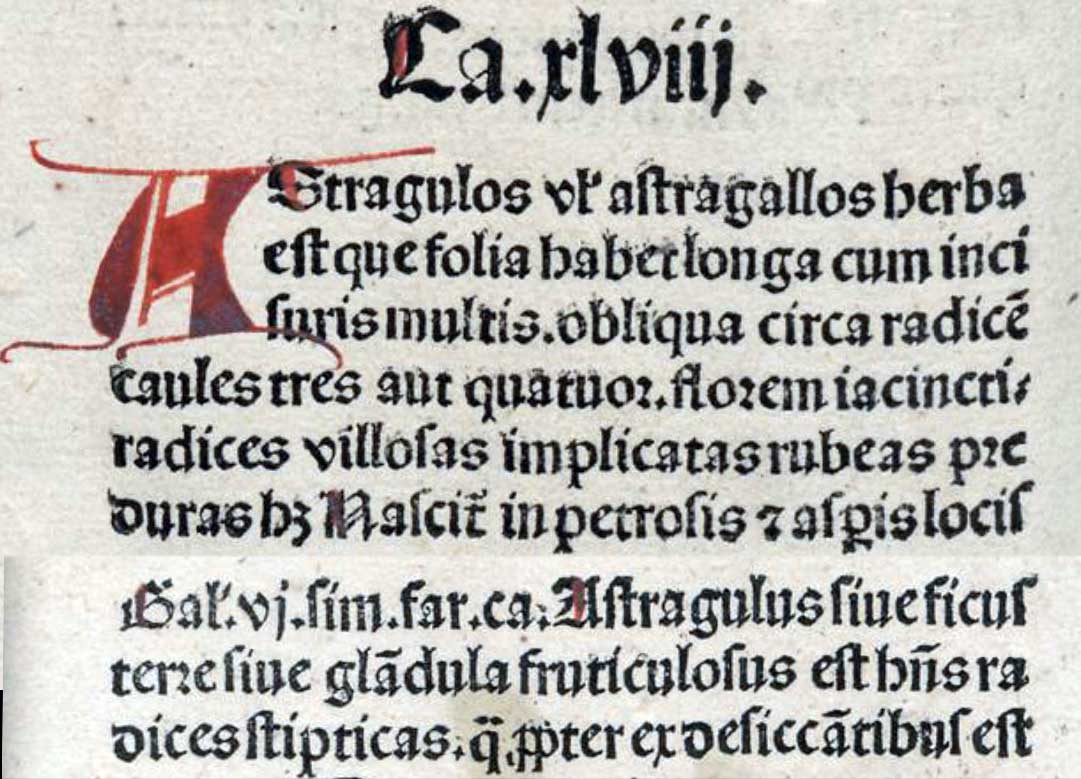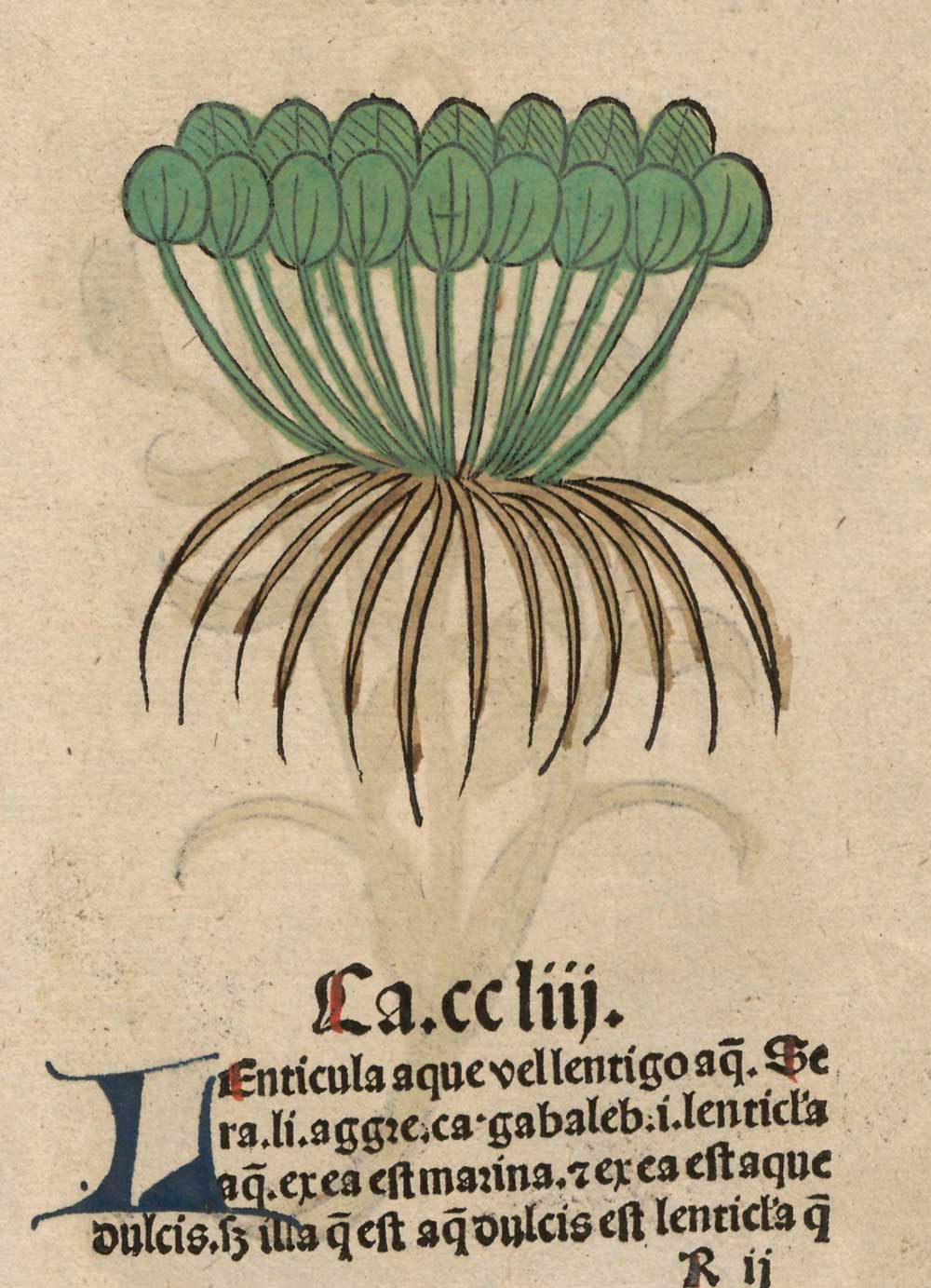Original French: Pourtãt eſt il appelé Asbeſton.
Modern French: Pourtant est il appelé Asbeston.
Notes
Asbeston
C’est-à-dire, incombustible. Cette plante, cette espéce de lin dont parle Rabelais, croît non-seulement dans les Indes, comme le dit nôtre Auteur d’après Pline, Pausanias, & d’autres Écrivains, mais on en trouve dans le Pyrenées, & plusieurs Curieux en conservent de petits tissus. On en fait des lumignons de lampe, qui, dit-on, ne se consument jamais. Les Anciens en faisoient des toiles dont ils enveloppoient les corps morts qu’ils brûloient. Ces toiles étoient pareillement incombustibles. Au reste, il ne faut pas confondre ici, comme a fait M. le Duchat, le lin Asbestin, avec la pierre Asbestos, composée de filamens dont on faisoit des tissus semblables, destinés aux mêmes usages. Rabelais qui parle ailleurs de cette pierre, n’en fait ici aucune mention, & M. le Duchat a eu tort d’avancer que nôtre Auteur parloit ici de ces deux sortes de merveilles physiques.
François Rabelais [ca. 1483–1553]
Le Rabelais moderne, ou les Œuvres de Rabelais mises à la portée de la plupart des lecteursp. 168
François-Marie de Marsy [1714-1763], editor
Amsterdam: J.-F. Bernard, 1752
Google Books
asbeston
Partant il est appelé incombustible. Asbeston ou asbeste vient du grec ἄδεστον, inextinguibilis, de α privatif et σζέννυμι, exstinguo. Cette plante, cette espèce de lin dont parle Rabelais, dit l’abbé de Marsy, croît non seulement dans les Indes, comme le dit notre auteur d’après Pline, Pausanias, et d’autres écrivains, mais on en trouve dans les Pyrénées, et plusieurs curieux en conservent de petits tissus. On en fait des lumignons de lampe, qui, dit-on, ne se consument jamais. Les anciens en faisoient des toiles dont ils enveloppoient les corps morts qu’ils brûloient: ces toiles étoient pareillement incombustibles. Au reste, il ne faut pas confondre ici, comme a fait Le Duchat, le lin asbestin avec la pierre asbestos composée de filaments dont on faisoit des tissus semblables, destinés aux même usages. Rabelais, qui parle ailleurs de cette pierre, n’en fait ici aucune mention, et Le Duchat a eu tort d’avancer que notre auteur parloit ici de ces deux sortes de merveilles physiques.
François Rabelais [ca. 1483–1553]
Œuvres de Rabelais (Edition Variorum). Tome Cinquièmep. 290
Charles Esmangart [1736-1793], editor
Paris: Chez Dalibon, 1823
Google Books
asbeston
Du grec ἄσδεστον, incombustible. Il n’y a aucune autre analogie que celle des possibilités textiles entre le chanvre et l’asbeste que Rabelais nomme pantagruelion asbestin. Confusion déjà commise par Pline, qui considère l’asbeste comme un var. incombustible du lin: «Inventum jam est etiam [linum] quod ignibus non absumeretur… Nascitur in desertis adustique sole Indiæ ubi non cadunt imbres… vocatur autem a Græcis asbestinum». Pline, XIX, 4. L’asbeste, ou amiante, est un var. filamenteuse (par altération) de l’amphibole trémolite, (silicate de chaux et de magnésie). Les filaments soyeux sont assez longs pour en permettre le tissage; les Anciens en faisaient des mèches perpétuelle pour leurs lampes, et des linceuls incombustibles pour recueillir la cendre des morts.
François Rabelais [ca. 1483–1553]
Oeuvres. Tome Cinquieme: Tiers Livre. Édition critiquep. 371
Abel Lefranc [1863-1952], editor
Paris: Librairie Ancienne Honoré Champion, 1931
Archive.org
Asbeston
Inventum iam est etiam quod ignibus non absumeretur. vivum id vocant, ardentesque in focis conviviorum ex eo vidimus mappas sordibus exustis splendescentes igni magis quam possent aquis. regum inde funebres tunicae corporis favillam ab reliquo separant cinere. nascitur in desertis adustisque Indiae locis, ubi non cadunt imbres, inter diras serpentes, adsuescitque vivere ardendo, rarum inventu, difficile textu propter brevitatem; rufus de cetero colos splendescit igni. cum inventum est, aequat pretia excellentium margaritarum. vocatur autem a Graecis ἀσβέστινον ex argumento naturae suae. Anaxilaus auctor est linteo eo circumdatam arborem surdis ictibus et qui non exaudiantur caedi. ergo huic lino principatus in toto orbe.
Also a linen has now been invented that is incombustible.It is called ‘live’ linen, and I have seen napkins made of it glowing on the hearth at banquets and burnt more brilliantly clean by the fire than they could be by being washed in water. This linen is used for making shrouds for royalty which keep the ashes of the corpse separate from the rest of the pyre. The plant [It is really the mineral asbestos] grows in the deserts and sun-scorched regions of India where no rain falls, the haunts of deadly snakes, and it is habituated to living in burning heat; it is rarely found, and is difficult to weave into cloth because of its shortness; its colour is normally red but turns white by the action of fire. When any of it is found, it rivals the prices of exceptionally fine pearls. The Greek name for it is asbestinon [‘Inextinguishable’], derived from its peculiar property. Anaxilaus states that if this linen is wrapped round a tree it can be felled without the blows being heard, as it deadens their sound. Consequently this kind of linen holds the highest rank in the whole of the world.
Pliny the Elder [23–79 AD]
The Natural History. Volume 5: Books 17–1919.04
Harris Rackham [1868–1944], translator
Cambridge, Massachusetts: Harvard University Press, 1950
Loeb Classical Library
abeston
Rabelais suit toujours Pline, qui fait de l’asbeste une variété du lin. L’utilité du lin asbestin dans les crémations est mentionée par Pline (XIX, 4: « Inventus jam est etia [Linum] quod ignibus non absumeretur; regum inde funebres tunicae corporis favellam ab reliquo separant cineri. Nascitur in desertis adutisque Indiae locis. […] Vocatur autem a Graecis [greek], ex argumento naturae suae ». Le passage de Pline était bien connu; cf. P Vergile, De Inventoribus rerum, II, x. L’adjectif carpasien est le carbaseus (ou, carbasinus) des Latins ( = « ce qui est fait de lin ou de chanvre ».)
François Rabelais [ca. 1483–1553]
Le Tiers Livre. Edition critique
Michael A. Screech [b. 1926], editor
Paris-Genève: Librarie Droz, 1964
Asbeston
Voir Gargantua, V, p. 19 et n. 22, où l’asbeston est un pierre; ici, Rabelais suit Pline XIX, iv: l’asbeste ou amiante est une variété incombustibvle du lin et l’on en fait des linceuls royaux séparant des autres les cendres du corps (voir Tiers livre, éd. Lefranc, n. 15, p. 372).
François Rabelais [ca. 1483–1553]
Œuvres complètes
p. 510, n. 6
Mireille Huchon, editor
Paris: Gallimard, 1994
asbeston
Page 509, n. 4. Par ailleurs, le pantagruélion n’est pas seulement le lin-chanvre suggéré par les descriptions botaniques du chapitre XLIV. Ce chapitre porte sue les vertus de pantagruélion asbeste. Dans Gargantua («la pierre dit ἁσβεστοζ»; voir V, p. 19 et n. 22; ici, p. 510 et n. 6), l’asbeston est une pierre, vraisemblablement l’amiante. Les Ancien s’en servaient pour faire des lincuels incombustibles que recueillaient la cendre des morts. Elle est pour les alchimistes le nom qu’ils donnent à leur pierre dans la mesure où elle résiste aux atteintes du feu (voir n. 4, p. 400). L’incombustibilité est ici la particularité essentielle du pantagruélion; dans la liste des elements incombustibles qu’il surpasse dans son excellence — salamandre, alun de plomb, éon, mélèze —, il est dit que ce dernier qu’il pourrait être digne d’être vrai pantagruélion. La blancheur du pantagruélion est aussi soulignée. Or, l’incombustibilité et la blancheur sont les caractéristiques mêmes de la matière des alchimistes après la putrification, la matière ayant alors «acquis un degré de fixie que le feu ne sçauroit detruire» (ibid, p. 58). Derrière le pantagruélion, Rabelais entend donc aussi la pierre philosophale, utilisant comme dans Thélème les ressources de l’art stéganographique (voir la Notice de Gargantua, p. 1042), proposant ainsi comme dans l’énigme en prophétie des objects différents à la sagacité de son lecteur.
François Rabelais [ca. 1483–1553]
Œuvres complètes
p. 509, n. 4
Mireille Huchon, editor
Paris: Gallimard, 1994
asbeston
Inspiré de Pline, XIX, 1 : «Finalement on a trouvé une sorte de lin qui ne se consume point au feu. Nos gens l’appellent lin de vif. Et de fait, j’en ay veu des nappes de festins, qu’on jettoit au feu au sortir de table, où elles se nettoyoient mieux cent fois qu’elles n’eussent fait en l’eau, et ne se gastoient point. Mesmes és obseques et funerailles des Rois, on revest leur corps de ces toiles, afin de pouvoir separer les cendres de leurs corps d’avec celles de parfums et des bois odorants où on les brusloit. […] Les Grecs suyvans la proprieté de sa nature l’appellent Asbestinos [=incombustible]» (trad. Du Pinet).
François Rabelais [ca. 1483–1553]
Le Tiers Livre. Edition critique
p. 470
Jean Céard, editor
Librarie Général Français, 1995
asbestos
Asbestos use dates back at least 4,500 years, when the inhabitants of the Lake Juojärvi region in East Finland strengthened earthenware pots and cooking utensils with the asbestos mineral anthophyllite (see Asbestos-ceramic).[16] The word asbestos comes from the ancient Greek ἄσβεστος, meaning “unquenchable” or “inextinguishable”.[1][17] One of the first descriptions of a material that may have been asbestos is in Theophrastus, On Stones, from around 300 BC, although this identification has been questioned.[18] In both modern and ancient Greek, the usual name for the material known in English as “asbestos” is amiantos (“undefiled”, “pure”) whence the term for it in, e.g., French amiante and Portuguese amianto. In modern Greek, the word ἀσβεστος or ασβέστης stands consistently and solely for lime.
The term asbestos is traceable to Roman naturalist Pliny the Elder’s manuscript Natural History, and his use of the term asbestinon, meaning “unquenchable”.[1][16][17] While Pliny is popularly credited with recognising the detrimental effects of asbestos on human beings,[19] it has been said that examination of the primary sources reveals no support for that claim.[20]
Wealthy Persians amazed guests by cleaning a cloth by exposing it to fire. For example, according to Tabari, one of the curious items belonging to Khosrow II Parviz, the great Sassanian king (r. 531–579), was a napkin (Persian: منديل) that he cleaned simply by throwing it into fire. Such cloth is believed to have been made of asbestos imported over the Hindu Kush.[21] According to Biruni in his book, Gems, any cloths made of asbestos (Persian: آذرشست, āzarshost) were called shostakeh (Persian: شستكه).[22] Some Persians believed the fiber was the fur of an animal, called the samandar (Persian: سمندر), which lived in fire and died when exposed to water,[23][24] whence the former belief that the salamander could tolerate fire.[25]
Charlemagne, the first Holy Roman Emperor (800–814), is said to have had a tablecloth made of asbestos.[26]
Marco Polo recounts having been shown, in a place he calls Ghinghin talas, “a good vein from which the cloth which we call of salamander, which cannot be burnt if it is thrown into the fire, is made …”[27]
Some archeologists believe that ancients made shrouds of asbestos, wherein they burned the bodies of their kings, in order to preserve only their ashes, and prevent them being mixed with those of wood or other combustible materials commonly used in funeral pyres.[28][page needed][unreliable source?][29] Others assert that the ancients used asbestos to make perpetual wicks for sepulchral or other lamps.[23] In more recent centuries, asbestos was indeed used for this purpose. Although asbestos causes skin to itch upon contact, ancient literature indicates that it was prescribed for diseases of the skin, and particularly for the itch. It is possible that they used the term asbestos for soapstone, because the two terms have often been confused throughout history.[28]
1 Alleman, James E.; Mossman, Brooke T (July 1997). “Asbestos Revisited” (PDF). Scientific American. 277: 54–57. Bibcode:1997SciAm.277a..70A. doi:10.1038/scientificamerican0797-70. Archived from the original (PDF) on 3 June 2010. Retrieved 26 November 2010.
2 Gee, David; Greenberg, Morris (9 January 2002). “Asbestos: from ‘magic’ to malevolent mineral” (PDF). Late lessons from early warnings: the precautionary principle 1896–2000. Copenhagen: EEA (22): 52–63. ISBN 92-9167-323-4. Retrieved 20 April 2010.
3 Position Statement on Asbestos from the Joint Policy Committee of the Societies of Epidemiology (JPC-SE), approved June 4, 2012
4 BrancheArbejdsmiljøRådet for Bygge & Anlæg (February 2009). Når du støder på asbest. Branchevejledning (in Danish). Copenhagen. pp. 6–7. ISBN 978-87-7952-118-6.
5 Best, Richard. “Liability for Asbestos Related Disease in England and Germany” (PDF). germanlawjournal.com. Retrieved July 29, 2015.
6 Shorter Oxford English Dictionary (5th ed.). Oxford University Press. 2002.
7 “Asbestos, CAS No. 1332-21-4” (PDF). Archived from the original (PDF) on 29 April 2011.
8 Berman, D Wayne; Crump, Kenny S (2003). Final draft:technical support document for a protocol to assess asbestos-related risk. Washington DC: U.S. Environmental Protection Agency. p. 474.
9 “What is asbestos?”. American Cancer Society. Retrieved 12 January 2010.
10 “Asbestos – History and Uses”. Wisconsin Department of Natural Resources. 31 August 2007. Archived from the original on 28 December 2007.
11 Occupational Exposure to Asbestos, Tremolite, Anthophyllite and Actinolite. U.S. Department of Labor. 1992
12 Asbestos mining stops for first time in 130 years. Canadian Broadcasting Corporation. 24 November 2011
13 Dougherty, Kevin (20 November 2012) Quebec Budget: Finance Minister Nicolas Marceau tightens spending, levies new taxes. Ottawa Citizen
14 “Asbestos” (PDF). U.S. Geological Survey Mineral Resources Program. January 2010. Retrieved 25 August 2016.
15 “Asbestos” (PDF). U.S. Geological Survey Mineral Resources Program. January 2016. Retrieved 25 August 2016.
16 Ross, Malcolm & Nolan, Robert P (2003). “History of asbestos discovery and use and asbestos-related disease in context with the occurrence of asbestos within the ophiolite complexes”. In Dilek, Yildirim & Newcomb, Sally. Ophiolite Concept and the Evolution of Geological Thought. Special Paper 373. Boulder, Colorado: Geological Society of America. ISBN 0-8137-2373-6.
17 Bostock, John (1856). “Asbestinon”. The Natural History of Pliny. Vol. IV. Translated by Riley, H. T. London: Henry G. Bohn. p. 137. Retrieved 26 November 2010.
18 Caley, Earl R.; Richards, John F. C. (1956). “Commentary”. Theophrastus on Stones: Introduction, Greek Text, English Translation, and Commentary. Graduate School Monographs: Contributions in Physical Science, No. 1. Columbus, OH: The Ohio State University. pp. 87–88. Retrieved 31 January 2013. “Moore thought that Theophrastus was really referring to asbestos. The color of the stone makes this unlikely, though its structure makes it less improbable, since some forms of decayed wood do have a fibrous structure like asbestos … It is, however, unlikely that Theophrastus is alluding to asbestos, since the mineral does not occur in the locality mentioned … It is much more probable that Theophrastus is referring to the well-known brown fibrous lignite.”
19 Barbalace, Roberta C. (22 October 1995). “History of Asbestos”. Environmentalchemistry.com. Retrieved 12 January 2010.
20 Maines, Rachel (2005). “Erroneous assertions debunked via reading of primary sources”. Asbestos and Fire: Technological Trade-offs and the Body at Risk (All assertions about Pliny noticing health effects cite sources other than Pliny himself, despite his works being translated, available to read, and in the electronic age, text searchable). Rutgers University Press. p. 26. ISBN 0-8135-3575-1.
21 New Encyclopædia Britannica (2003), vol. 6, p. 843
22 Dehkhoda Persian Dictionary
23 “University of Calgary”. Iras.ucalgary.ca. 30 September 2001. Retrieved 12 January 2010.
24 A Brief History of Asbestos Use and Associated Health Risks EnvironmentalChemistry.com website
25 Fantastically Wrong: The Legend of the Homicidal Fire-Proof Salamander”. WIRED. Retrieved 2016-05-03.
26 “Science: Asbestos”. Time. 29 November 1926. Archived from the original on 31 January 2011. Retrieved 11 January 2011.
27 Polo, Marco; A C. Moule; Paul Pelliot (1938). Marco Polo: the Description of the World: A.C. Moule & Paul Pelliot. G. Routledge & Sons. pp. 156–57. Retrieved 31 January 2013.
28 History of science This article incorporates content from the 1728 Cyclopaedia, a publication in the public domain.
29 Pliny the Elder. Ch. 4.—LINEN MADE OF ASBESTOS. In The Natural History
asbestos
asbestos. Forms: asbeston, abeston, abiston, albeston(e; absistos, asphestus, asbestos, asbestus; abestos, -istos; abbest, asbest. [The modern form is adopted from Latin asbestos (modern Latin asbestus), adopted from Greek asbestoj, `inextinguishable, unquenchable,’ formed on a not + sbestoj, formed on sbennunai to quench. Old French had also adopted from Latin, asbestos, later abestos, whence an English form abestos; but the common Old French form was adopted from Latin asbeston, phonetically changed to abeston, and (by confusion with albus white) albeston; hence the earlier English forms asbeston, abeston, abiston, albeston, and (by assimilation to stone) albestone. Modern French is asbeste, formerly also abeste.]
As a substantive asbestos was applied by Dioscorides to quicklime (`unslaked’). Erroneously applied by Pliny to an incombustible fibre, which he believed to be vegetable, but which was really the amiantos of the Greeks. Since the identification of this, asbestos has been a more popular synonym for amiantus or amiant.
`The unquenchable stone’; a fabulous stone, the heat of which, when once kindled, was alleged to be unquenchable. (A distorted reference to the phenomena observed in pouring cold water on quick lime.) Obsolete
1387 John de Trevisa Higden (Rolls Series) 187 Asbeston þat wil neuere quenche, be it ones i-tend.
1398 John de Trevisa Bartholomeus De proprietatibus rerus xvi. xi. (1495) 558 Of albestone… was made a candyll sticke on whiche was a lantern so brennynge that it myght not be quenched wyth tempeste nother with reyne.
1567 John Maplet A green forest or a naturall historie, wherein may be seen … the most sufferaigne vertues in all … stones and mettals … plantes, herbes … brute beastes etc. 2 Albeston is a stone of Archadie.
1567 Maplet Green forest 2 b, The precious stone Absistos… being once heate, keepeth hote seauen whole dayes.
1610 Gwillim Heraldry iv. ix. (1660) 307 A certain Kind of Stone that is found in Arcadia… called Asphestus.
1627 Henry Burton Bait. Pope’s Bull 63 The stone Asbestos… once inflamed, cannot be quenched againe.
An alleged kind of incombustible flax. Obsolete (An erroneous notion of the mineral substance.)
A. 1661 Barton Holyday, translator D. J. Juvenalis and A. Persius Flaccus 207 A sheet made of a kind of flax, call’d asbestinum, and asbeston… of that nature, that it is not consum’d, but only cleans’d, by the fire.
1734 translator Rollin’s Ancient History, Pliny gives the first place to the asbeston, the incombustible flax.
A mineral of fibrous texture, capable of being woven into an incombustible fabric; amiant or amiantus. In mineralogy applied more widely than Amiantus, to all fibrous varieties of Hornblende or Amphibole, and of Pyroxene; Amiantus being specifically the finest Hornblende Asbestos, distinguished by its long silky fibres, usually pearly white.
1607 Edward Topsell The history of foure-footed beasts and serpents 749 This kinde of web rather cometh of a kinde of flax that Pliny writeth of, or rather of the Amiantus-stone, called the Asbest, which… being cast into a fire, seems to be forthwith all in a flame, but being taken out again, it shineth the more gloriously.
1609 Thomas Heywood Troia Britanica; or Great Britaines Troy i. lxviii, An abbest stone into the bole was brayed.
1667 Philosophical Transactions of the Royal Society II. 486 Of Asbestus, that can be drawn and spun.
1783 Wedgewood Philosophical Transactions of the Royal Society LXXIII. 286 Filaments… of asbestos, which suffer no change in a moderate red heat.
C. 1815 Robert Southey Yng. Dragon i. Wks. VI. 263 With amianth he lined the nest, And incombustible asbest.
fossil linen
fossil linen: a kind of asbestos. Obsolete
1797 Encyclopædia Britannica (ed. 3) X. 83/2 Fossile Linen is a kind of amianthus, which consists of flexible, parallel, soft fibres,… celebrated for the uses to which it has been applied, of being woven, and forming an incombustible… .
